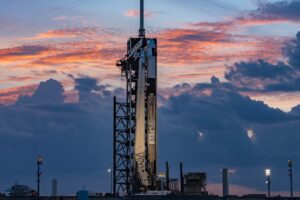Spacex explotion In four to six weeks, the updated Starship will undergo another round of testing. A third failure in a row might point to serious issues with the revised design.

SpaceX Starship Loses Control After Launch, Debris Falls Over the Bahamas
SpaceX’s Starship rocket went out of control just minutes after liftoff on Thursday, scattering fiery debris over the Bahamas. This marks another setback for Elon Musk’s ambitious space program, coming less than two months after a similar failure.
Loaded with millions of pounds of methane and liquid oxygen propellants, the Starship and its Super Heavy booster lifted off from the Texas launchpad at 5:30 PM Central Time. This was the eighth full-scale test flight of SpaceX’s next-generation rocket.
Powered by thirty-three Raptor engines, the massive 404-foot (123.1-meter) tall rocket soared into the clear afternoon sky with more than twice the thrust of NASA’s Saturn V—the workhorse rocket of the Apollo moon missions.
SpaceX Advances in Booster Recovery While Starship Block 2 Faces Obstacles.
About two and a half minutes after liftoff, SpaceX successfully separated the Super Heavy booster from the Starship’s upper stage, repeating a feat it had accomplished twice previously. After that, the booster steered back toward the Texas coast in hopes of being captured by the launch tower’s mechanical arms.
The fact that SpaceX has now successfully returned the Super Heavy booster to the launch site three times with this mission shows that engineers are making good progress toward recovering and reusing the booster, as they have already done with the smaller Falcon 9 rocket.
However, SpaceX is currently 0–2 in test flights for the most recent iteration of the Starship, also referred to as Block 2 or Version 2. The company is currently updating its fleet with Block 2, a slightly longer version of the vehicle that can hold more propellant than the previous model, which was used in the first six Starship test flights.
Additionally, Starship Block 2 has tiny forward flaps that provide an additional line of defense against the intense heat of re-entry. A revamped fuel-line system to more effectively supply propellant to the rocket’s six Raptor engines is another important update in Block 2.
Hardware Rich
Elon Musk Says There Will Be More Starships After a Small Setback
The good news is that SpaceX won’t have to wait long to make another attempt because multiple additional Starship rockets are currently being built in South Texas. Although the company set an ambitious goal to launch 25 Starship test flights this year when it began 2025, the first quarter is coming to an end with just two flights.
Elon Musk, the CEO of SpaceX, stated on X (formerly Twitter) that this was only a minor setback. “Time is used to measure progress. In four to six weeks, the next ship will be prepared.

NASA’s $4 billion agreement with SpaceX opens the door for missions to the moon and mars.
Based on the Starship design, SpaceX and NASA have agreed to a nearly $4 billion contract for the design and development of a human-rated moon lander. NASA’s Artemis program, which intends to send humans back to the moon by the end of this decade, includes this Starship lander as a crucial component.
SpaceX will have to refuel Starship with ultra-cold propellant in low-Earth orbit in order for it to reach the Moon, an accomplishment never before attempted on this scale.
As one of his most ambitious long-term goals, Elon Musk sees Starship as the foundation of future interplanetary travel, able to transport both people and goods to Mars. Orbital refueling will be necessary for this mission as well. SpaceX may be prepared to demonstrate ship-to-ship orbital refueling by 2026, Musk recently hinted, one year later than NASA’s internal goal of 2025, which officials discussed last December.
Next-Gen Starlink satellites will be launched by the ship, but the performance of the heat shield is still uncertain.
1) SpaceX plans to launch its next-generation Starlink internet satellites aboard Starship. The ground crew tested the rocket’s deployment mechanism by loading four mock-up Starlink units into Starship’s payload bay prior to Thursday’s launch.
2)Similar to what SpaceX has already been doing with the Super Heavy booster, officials were keen to assess the effectiveness of Starship Block 2’s heat shield before committing fully to using the vehicle for upcoming missions. However, those objectives will have to wait until another day because this test flight ended too soon.
3)SpaceX uses an iterative cycle to oversee Starship’s development. Engineers rapidly design, test, and then apply the lessons learned to the rocket’s subsequent iteration. It is not surprising that some rockets fail during this trial-and-error process.
However, given how similar they are, repeated failures may point to a more serious problem that requires attention.
Before a controlled reentry on Thursday, a half-world journey is scheduled.
4)The flight plan for Thursday’s mission called for Starship to travel halfway around the world from Texas, make a controlled reentry over the Indian Ocean, and splash down northwest of Australia.
5)This test flight was perceived as a follow-up to the Starship launch on January 16, when the upper stage of the rocket—often referred to as the Starship or simply “the ship”—caught fire due to a propellant leak in the engine bay.
Engineers later determined that the leak was most likely caused by a harmonic response that was several times stronger than expected. This suggested that the vibrations experienced during the ship’s space flight aligned with the vehicle’s inherent frequency, potentially making them far more intense than the engineers had anticipated.